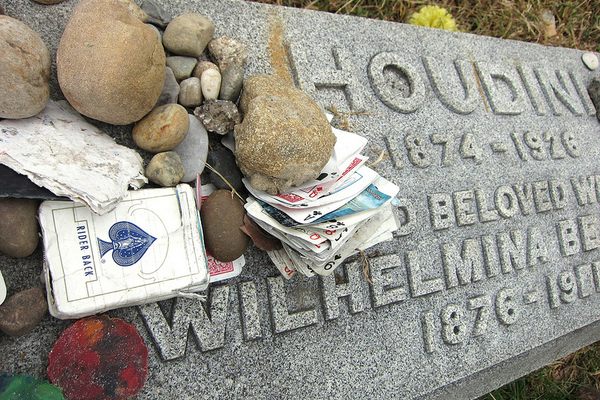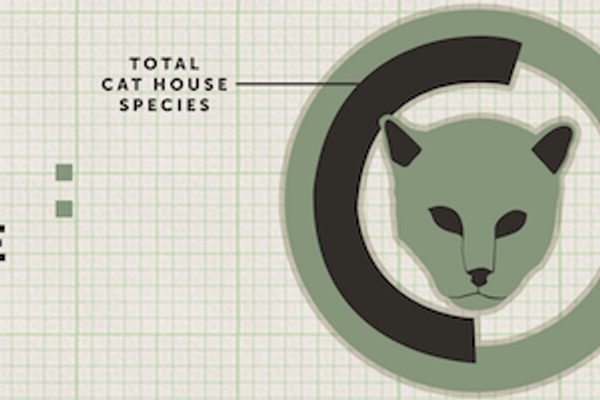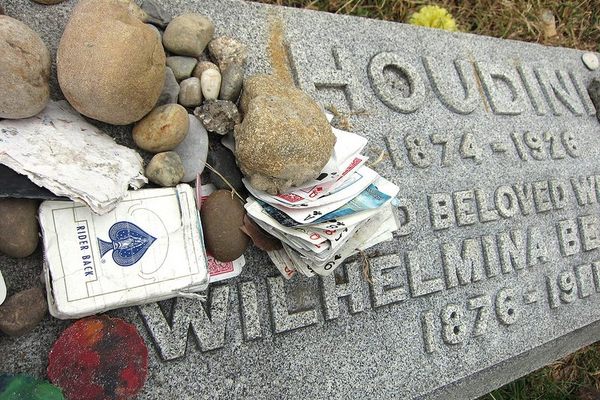Waiting for Houdini to Escape from Death
31 Days of Halloween: On Atlas Obscura this month, we’re celebrating Halloween each day with woeful, wondrous, and wickedly macabre tales all linked to a real locale that you can visit, if you dare.
Grave of Houdini (photograph by Allison Meier)
“If I die, don’t be surprised if the phony spiritualists declare a national holiday,” Houdini said during one of his last meals. Though the magician had earned his fame fighting straitjackets, locks, and sealed chests thrown into the East River, in later life he turned to combating fraudulent Spiritualists, whom he thought were duping the populace into believing in false proof of life after death.
Houdini preparing for an overboard box escape in 1912 (via Library of Congress)
Houdini met his end on Halloween in 1926. On the day of a show at the Princess Theatre in Montreal, a student at McGill University came backstage and asked if it was true Houdini could withstand a blow to the stomach. Told yes, the student rained sharp blows upon Houdini’s abdomen until some other students begged him to stop. Houdini was nursing a broken ankle and lying down on a couch, not standing in the tensed position he usually held when someone wanted to test his abs of steel.
Later that day, Houdini began suffering from pain in his stomach, but refused to go to the hospital. It was only after his wife Bess threw a fit that he came under a doctor’s care. Once in the operating room, pus flowed from his abdomen and dripped onto the hospital floor; Houdini’s appendix had ruptured and turned gangrenous. Some reports say the student’s blows killed Houdini, although several biographers note that it’s more likely that Houdini was already suffering from appendicitis when he arrived in Montreal. The magician stoically ignored his pains, assuming they were from injury rather than a condition that required immediate medical attention. Having come so far using his iron will to control his physical self, he was loath to give in to the needs of his body even when it might have saved him. Like every hero, he had a fatal flaw.
The Houdini family plot in Machpelah Cemetery (photograph by the author)
Houdini died in his wife’s arms, with the name of a famous lecturer on agnosticism — Robert Ingersoll — on his lips. Over 2,000 mourners crowded into the Elk’s Lodge ballroom on West 43rd Street in Manhattan for the funeral. Houdini had asked to be buried in a bronze casket purchased for one of his acts, with his beloved mother’s letters placed in a black bag and propped beneath his head as a pillow. As the coffin was lowered into the ground at the Machpelah Cemetery in Queens, one pallbearer whispered to another “Suppose he isn’t in it?”
Poster for a 1908 Houdini performance at the Circus Busch in Berlin (via Library of Congress)
Before his death, Houdini left secret codes with family and friends — messages that if heard during a séance would prove Houdini was trying to say hello. (Though he crusaded against fraudulent mediums, Houdini was more than willing to countenance the idea that something of the mind survives beyond the grave.) For years, Bess would shut herself in her room on Sundays at the hour of her husband’s death, staring at a photo of him and awaiting a sign. As far as anyone knows, none ever came. Bess also began a tradition of holding Halloween séances in an attempt to contact Houdini’s spirit, a tradition that continues today in several locations around the globe.
Magician Tarot card at Houdini’s grave (photograph by Allison Meier)
Monument to Houdini at the cemetery (photograph by Allison Meier)
Vandals have repeatedly attacked Houdini’s family plot at Machpelah, smashing the granite benches and crypt covers and damaging the tomb foundations. The plot was restored thanks in part to the local chapter of the Society of American Magicians, of which Houdini was president when he died. Donations for the restoration reportedly came from David Copperfield, a fitting tribute since Houdini paid for the restoration of several other magicians’ graves while he was alive.
A Santa Muerte candle & playing cards left at Houdini’s monument (photograph by Allison Meier)
Today, Houdini’s grave is decorated with pebbles, coins, and playing cards left by well-wishers. On a recent visit by Atlas Obscura staff, a Santa Muerte candle was perched at the top of the plot next to a grieving female figure cast in stone. Santa Muerte, sometimes called the “Skeleton Saint” or the “Bony Lady,” is a Mexican folk saint who is considered the personification of death. She has a growing cult in Mexico and the United States that often draws worshippers from society’s most downtrodden and dispossessed, including the very poor, the transgendered, drug dealers, and prisoners.
These devotees frequently appeal to Santa Muerte for help getting out of tight situations, which makes the candle on Houdini’s grave fitting. It’s notable, too, that the candle represents the two things Houdini fought against most: the supernatural, and death itself.
Harry Houdini diving handcuffed into the water (via The New York Public Library for the Performing Arts)
Bess Lovejoy is a writer, researcher, and editor based in Brooklyn. Her book Rest in Pieces was published this year by Simon & Schuster. She worked on the Schott’s Almanac series for five years, and her writing has also appeared in The New York Times, The Believer, The Boston Globe, and elsewhere. This Tuesday, she is speaking on “Roving Body Parts & Restless Dead: NYC’s most notoriously mobile corpses” with the Obscura Society at Acme Studios in Brooklyn.
HOUDINI’S GRAVE, Queens, New York
Click here for more of our 31 Days of Halloween, where each day we’re celebrating the strange-but-true unsettling corners of the world.



















Follow us on Twitter to get the latest on the world's hidden wonders.
Like us on Facebook to get the latest on the world's hidden wonders.
Follow us on Twitter Like us on Facebook